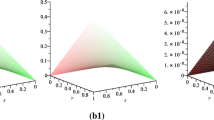Abstract
In this paper the authors have dealt with seven kinds of non-linear Volterra and Fredholm classes of equations. The authors have formulated an algorithm for solving the aforementioned equation types via Hybrid Function (HF) and Triangular Function (TF) piecewise-linear orthogonal approach. In this approach the authors have reduced integral equation or integro-differential equation into equivalent system of simultaneous non-linear equation and have employed either Newton’s method or Broyden’s method to solve the simultaneous non-linear equations. The authors have calculated the L2-norm error and the max-norm error for both HF and TF method for each kind of equations. Through the illustrated examples, the authors have shown that the HF based algorithm produces stable result, on the contrary TF-computational method yields either stable, anomalous or unstable results.






























Similar content being viewed by others
References
A.-M. Wazwaz, Linear and Nonlinear Integral Equations: Methods and Applications (Springer, Berlin, 2011). ISBN 978-3-642-21448-6
H. Brunner, Implicitly linear collocation method for nonlinear Volterra equations. Appl. Numer. Math. 9(3–5), 235–247 (1982)
M.G. Porshokouhi et al., Numerical solution for non-linear Fredholm integral equations by Newton–Kantorovich method and comparison with HPM and ADM. Int. J. Pure Appl. Sci. Technol. 3(1), 44–49 (2011)
Jafar. Biazar, Mostafa. Eslami, Homotopy perturbation and Taylor series for Volterra integral equations of the second kind. Middle-East J. Sci. Res. 7(4), 604–609 (2011)
K. Kumar, I.H. Sloan, A new collocation-type method for Hammerstein integral equations. Math. Comp. 48(178), 585–593 (1987)
G.Q. Han, Asymptotic error expansion of a collocation-type method for Volterra–Hammerstein integral equations. Appl. Numer. Math. 13(5), 357–369 (1993)
A. Deb, A. Dasgupta, G. Sarkar, A new set of orthogonal functions and its application to the analysis of dynamic systems. J. Frankl. Inst. 343, 1–26 (2006)
A. Deb, G. Sarkar, P. Mandal, A. Biswas, A. Ganguly, D. Biswas, Transfer function identification from impulse response via a new set of orthogonal hybrid functions (HF). Appl. Math. Comput. 218, 4760–4787 (2012)
A. Micke, M. Bulow, Application of Volterra integral equations to the modelling of the sorption kinetics of multi-component mixtures in porous media: I. Fundam. Gas Sep. Purif. 4(3), 158–164 (1990)
O. Diekmann, Thresholds and travelling waves for the geographical spread of infection. J. Math. Biol. 6, 109–130 (1978)
K. Maleknejad, M. Hadizadeh, A note on a nonlinear problem in cell membrane theory, nonlinear analysis. Theory Methods Appl. 30(6), 3947–3950 (1997)
M. Valipour, M.E. Banihabib, S.M.R. Behbahni, Comparison of the ARMA, ARIMA, and the autoregressive artificial neural network models in forecasting the monthly inflow of Dez dam reservoir. J. Hydrol. 476(7), 433–441 (2013)
D.P. Viero, Modeling anisotropy in free-surface overland and shallow inundation flows. Adv. Water Resour. 104, 1–14 (2017)
M. Valipour, Global experience on irrigation management under different scenarios. J. Water Land Dev. 32(1), 95–102 (2017)
M. Valipour, Variations of land use and irrigation for next decades under different scenarios. Irriga. Braz. J. Irrig. Drain. 1(1), 262–288 (2016)
M. Valipour, How much meteorological information is necessary to achieve reliable accuracy for rainfall estimations? Agriculture 6(4), 1–9 (2016)
M. Valipour, M.A.G. Sefidkouhi, M.R. Sarjaz, Selecting the best model to estimate potential evapotranspiration with respect to climate change and magnitudes of extreme events. Agric. Water Manag. 180(Part A), 50–60 (2017)
A. Deb, S. Roychoudhury, G. Sarkar, Analysis and Identification of Time-Invariant, Time-Varying and Multi-delay Systems Using Orthogonal Hybrid Functions: Theory and Algorithms with MATLAB ® , Studies in Systems, Decision and Control, vol. 46. Springer, Switzerland (2016)
A. Deb, S. Gautam, A. Sengupta, Triangular Orthogonal Functions for the Analysis of Continuous Time Systems (Anthem Press, London, 2011)
Author information
Authors and Affiliations
Corresponding author
Rights and permissions
About this article
Cite this article
Mukhopadhyay, A., Ganguly, A. & Chatterjee, S.D. Solution of Volterra and Fredholm Classes of Equations via Triangular Orthogonal Function (A Combination of Right Hand Triangular Function and Left Hand Triangular Function) and Hybrid Orthogonal Function (A Combination of Sample Hold Function and Right Hand Triangular Function). J. Inst. Eng. India Ser. B 99, 181–209 (2018). https://doi.org/10.1007/s40031-017-0297-1
Received:
Accepted:
Published:
Issue Date:
DOI: https://doi.org/10.1007/s40031-017-0297-1




